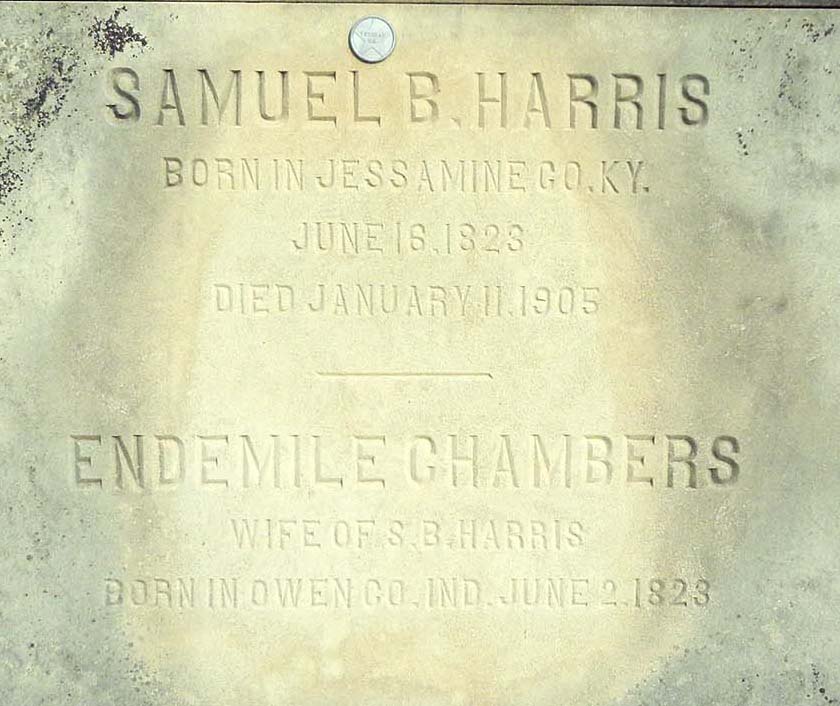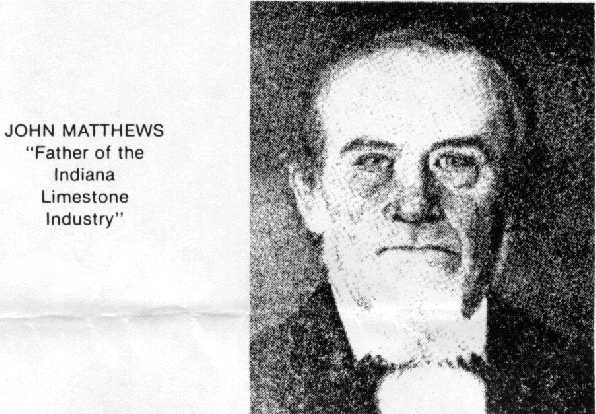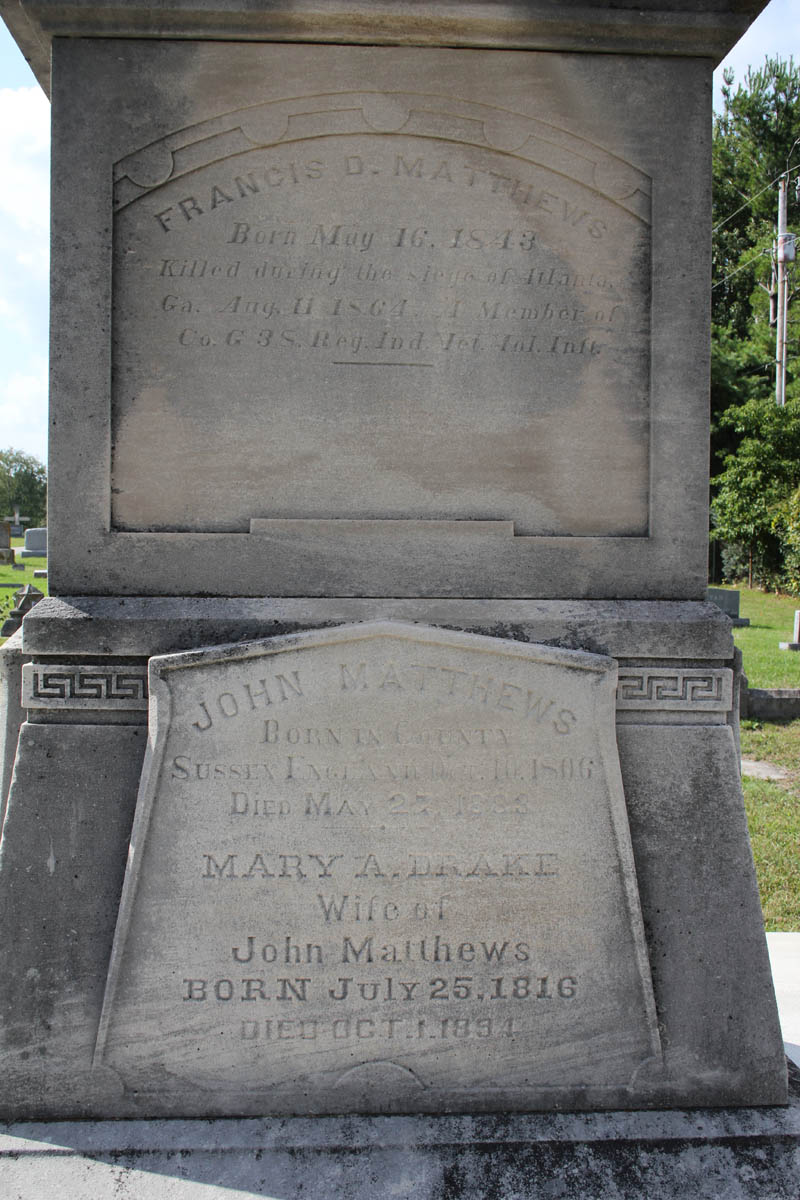Arrived in Ohio between 1849 and 1850. Found, with family, in Cincinnati, ward 10, Hamilton, Ohio. Called Mathews in 1880 census. Live Richland township, near Ellettsville, Indiana, Bean Blossom Township. The Father of the Indiana Limestone Industry. Mathers and Mathews in census records, probably an error.
JOHN MATTHEWS deceased (late of the firm of Matthews & Son, now P. T., William N. and Frederick Matthews), was born October 10,1806, in County Sussex, England; was apprenticed in London to the stone and marble work, and assisted at building some of the Parliament houses, etc. Here he married his wife, Miss Mary A. Drake; they had twelve children, seven of whom are living—Peter T., William N., Jane, James L., Susan, Phebe and Frederick. In 1849, the Matthews family left for America, were delayed on the voyage by a mutiny, and finally landed at New Orleans, where Mr. M. was offered inducements to remain; but he moved to Cincinnati, thence to Louisville, and thence to this State, in Jefferson County, and opened a quarry for Dean Bros.' In 1855, he came to this county and opened a quarry for himself, which he managed until his death. A specimen of this stone took first premium at the Centennial. He was a Union Democrat and a highly esteemed citizen. He died May 27, 1883, aged seventy-seven, a member of the Baptist Church; his wife is yet living, aged sixty-seven years. [Counties of Morgan, Monroe and Brown, Indiana: Historical and Biographical By Charles Blanchard Published 1884 F.A. Battey & Co.]
In 1862 John Matthews opened a quarry one mile north of Ellettsville. Two years thereafter he began the erection of a mill and pushed the business with great energy. From the first the firm of John Matthews & Sons realized a good profit from their business. The introduction of steam channeling machines and steam hoists gave a new impetus to the stone industry. The first channeling machine operated in the oolitic stone belt was a Ward well, purchased by the firm about 1877, at a cost of $6,000, five times the manufacturers' price today.
Matthews Bros.' Mill and Quarry. - The Matthews Bros.' quarry is on the west side of the railroad and the valley, and between G. K. Perry's upper and lower mills. The quarry extends along the creek bluff for more than a quarter of a mile, and is worked back into the bluff until the thickness of the stripping prevents further work with profit. As might be expected, along a face of this length there would be some variety in the stone. At the north end in places the rock is coarsely fossiliferous, containing many well preserved specimens of cephalopods and gastropods. At the extreme south end the rock exfoliates along the exposed channel face to some extent, that is—it flakes or peels off parallel with the surface, due to the freezing of the moist stone. In places near the middle of the quarry the stone is almost entirely made up of the oolitic or rounded particles.
The east-west vertical seams occur at intervals of 20 to 40 Eeel along the face. There are very few cross-seams. Several stylolitic (crowfeet) seams occur, but they are not numerous. In some places there are segregations of iron oxide and organic matter along these seams.
Most of the stone is buff in color, yet both buff and blue have been obtained, in some places intricately intermixed.
In 1000 the quarry was abandoned, having worked south about 700 feet from the present mills. There is still ample space, both south and north, for extensive quarrying, but the old company has found it more profitable and cheaper in the long run, to simply buy stone from near-by districts and cut it according to market orders. They still have the old mill intact without new additions in the matter of mill machinery. There are eight gang saws in operation which have furnished a great deal of good building stone to the market during the many years they have been in business here. Their sawed stone averaged without the freight rate attached about 40 cents per foot. The stone sawed is secured mainly from No. 18 quarry at Victor, Ind., from the Crescent quarry in the Hunter Valley district and the Empire quarry in the Sanders district. Twenty men are employed.
Matthews Bros, have made a small quarry opening on the hill east of the railroad, about a quarter of a mile east of Perry's upper mill. No railway connection has been made to the opening, and it is not now in operation. The rock is coarsely fossiliferous in places, and contains numerous seams, both vertical ones and stylolite (crowfoot) seams. Many of the stylolitic points along the seam are capped with fossils, most commonly cup-coral (Zaphrends. )
Near the middle of section 7, two miles east of Matthews Bros.' mill is one of the thickest beds of oolitic stone anywhere observed in the oolitic region, so far as can be judged by the outcrop and depending on the accuracy of the aneroid barometer, which makes the thickness of the oolitic stone at this point 100 feet. It is not uniform from top to bottom, and part of the bed is concealed by soil, but most of that exposed is of a quite fine grain and all buff on the outcrop. A. E.
Matthews Cut Stone Company. - In the bed of the old Matthews quarry, in the fall of 1903, the A. E. Matthews Stone Company established a mill for planing and cut work. All the stone sent out is finished and a great quantity of it is in artistic design. The stone is mainly bought ready sawed from the Matthews Bros. Company adjoining, and is then planed according to order by the two planers in the mill. Twelve men are employed at this mill, turning out about 20,000 cubic feet of stone each year. A gasoline engine is used for power, but is found inefficient in comparison with steam. More or less trouble is experienced with it in cold weather.
In 1872 John Matthews A- Sons and Kelly & Perry Bros. opened quarries on the west side of the Monon Railroad, about midway between Ellettsville and Stinesville. but after three years' operation it was found that they could not be profitably worked on account of the number of dry seams and joint cracks, so they were abandoned. The Cornelius quarry, on an adjoining tract, operated during the same time, suffered a like fate for similar reasons. In 1869 Sharp & Hight opened a quarry a little south of the Matthews quarry, but at the death of the owners, which occurred a few years afterward, the plant was sold to the Matthews, who extended their large quarry past it, thus developing the workable stone.
In 1869 Sharp & Hight opened a quarry a little south of the Matthews quarry, but at the death of the owners, which occurred a few years afterward, the plant was sold to the Matthews, who extended their large quarry past it, thus developing the workable stone. [Annual Report of the State Geologist By Indiana Geological Survey Published 1907]







